
Simple Wound Care Page Menu: 1 2 3 4 5 6 Next>>
Simple Wound Care in the Golden Age of Piracy, Page 2
Simple Wound Descriptions: Unbroken Skin
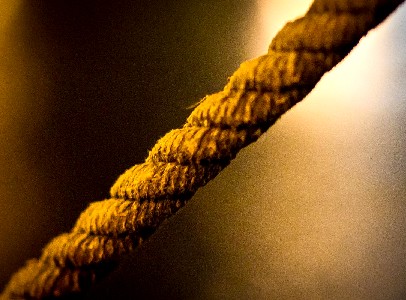
Photo: Tony Webster - Anchor Rope
There is even more support for occurrences on pirate ships likely to result in unbroken skin wounds during the golden age of piracy. While that is true, it is also true that the word 'bruise' is never mentioned in these accounts. In fact, the only sea-based account to to specifically refer to a bruise comes from a medical book. John Moyle discusses a case where the ship's anchor was dropped "and the Cable running out, a Kink therein happened to disaster a Mans Leg, in this manner"1. Even Moyle fails to use the word 'bruise' in that particular citation, although this case study is included in his explanation of healing 'deep Contusions, and Bruises without any eminent Wound'.
Pirate and sailor accounts usually only mention events that would cause such wounds. This is typically noted in the accounts by descriptions such as 'beating'2, 'drubbing'3, 'thrashing'4, 'abuse'5, and 'misuse'6. While none of these terms speak directly to the wounds produced by such actions, all would likely have caused bruising and contusions.
Beatings that would likely have resulted in bruises were employed for a variety of reasons by pirates. Sometimes men on ships captured ships were beat for being defiant. When Bartholomew Roberts' pirates came aboard his ship Elizabeth, William May was ordered to fix the topsail sheet block [a pulley on spar of the topsail] by pirate William Fernon. As he was going aloft, May said "We

Artist: N.C. Wyeth (1911)
shall see what brave fellows ye are; Ah, G-d d--n ye, (says this Fernon,) and I shall see too what a brave Fellow you are, when you come down; and beat him Very much."7
When captured ship crew member James Munjoy told pirate Joseph Mort he wasn't afraid of him, Mort "asked him with a great Oath, if he knew where he was, and gave him a very smart box on the Ear; and [Mort later] ...impudently told him, he would do the same were it to do again."8
While not many of the pirate accounts provide enough information about the day-to-day life of a ship to reveal how often men were beat, the trial of Bartholomew Roberts' crew gives some insight to this for that crew. The balance of this section will focus on testimony from the 163 cases associated with Roberts' crew.
Sometimes beatings were used to convince men on a captured vessel to join the pirates. During their testimony, several men who claimed they were beat to force them to go aboard the pirate ships including Edward Thorndon9, John Darvies10, William Champnies11, David Harding12 along with four others13. It must be noted that a common defense of a pirate on trial was to claim he was forced to join them through duress (which would include beating). As a result, a man on trial reporting that he was beat until he went aboard the pirate or signed their articles should be taken with a grain of salt.
More believable were testimonies from other witnesses that men were beat during the trial. There were even more examples of men being beat to force them to join the pirate in the trials of Roberts' men, including support for Robert Lilburn14, Benjamin Parr15, surgeon Adam Comrie16 and 10 other men.17 Beating a man seems like a curious way to convince men to join the pirates. When William May was beat by Roberts' pirates, he sourly noted in his testimony "that if he had had any Inclination to it [a life of pirating] he had received as an Earnest of their good-liking, [the beating] would have discouraged him from thinking of it"18.
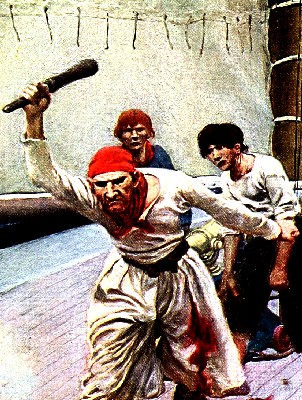
Artist: Howard Pyle - Then the Real Fight Began (1911)
Like cuts, unbroken skin wounds could also result from arguments that had spilled into violence. William Philips got into an argument over cheese which "was so warm in his persisting about his having of it, as a share he claimed among them [the pirates], that he quarrell'd with the Quarter-master, and was beat by another of the Pyrates. He said in his Defence ...that as to the Cheese, it was his own, and he thought he might want it, which engaged him into the Quarrel with the Quarter-master"19.
Eventual pirate William Davies left his ship the Ann Galley to live on shore following "a Quarrel with the second Mate of her, [the upshot of which was that] he beat him [the second mate] on Shore, and was for this Reason afraid to return on board again" and face the repercussions.20
Beating was sometimes used as a form of punishment. Pirate William "beat the Crew [of the captured ship King Solomon] for not being busy enough" when ordering George Fenn to put two cables [ropes] up.21 Captured musician James White noted that "he was forced ...to obey their Orders, and play their time [referring to music], or be beat"22.
Other times, beating was done out of sheer spite or even for no good reason at all. While off the coast of Brazil, John Cornelius' pirates "did a great deal of mischief' to the trade, and forced a great many men: these he put to do all the slavery of the ship, and they were beat about the decks, without daring to resent it."23 Upon capturing a ship called the Greyhound, George Lowther's crew "not only rifled the Ship, but whipp'd, beat, and cut the Men in a cruel Manner, turned them aboard their [the pirates'] own Ship, and then set Fire to their's [the Greyhound]."24 Deponent George Fenn reported that pirate John Mansfield of Bartholomew Robert's crew "was looked on as a Cypher [zero] among them, having sometimes a Share [of the plunder], and sometimes a Beating"25. (This statement also speaks rather curiously against the notion that all members of the crew were treated equally on a pirate ship.)
1 John Moyle, Abstractum Chirurgæ Marinæ, 1686, p. 61;2 There are literally dozens of examples of this in the pirate literature. See for example Captain Charles Johnson, The General History of the Pyrates, p. 304, 318 (Captain Bartholomew Roberts), 359 (Captain George Lowther), 412 (Captain Francis Spriggs); Captain Charles Johnson, The History of the Pirates, p. 136; The Tryals of Major Stede Bonnet, 1719, p. 23; "The Tryals of Thirty-Six Person for PIRACY", 1723 [Edward Low], British Piracy in the Golden Age, Volume 3, Joel Baer, ed., p. 9,10, 12 &A Full Account of the Tryal Of all the Pyrates Lately taken by Captain OGLE, 1723, p. 19, 23, 28. 29, etc; .3 While used less often, this term also appears many times in the pirate literature. See for example Johnson, General History, p. 233 (Roberts); Johnson, History of the Pirates, p. 162 (Captain John Cornelius), 4 This term is seldom used in the pirate literature, but it does appear. See for example Johnson, History of the Pirates, p. 153 (Cornelius), 5 This is found in the pirate trial documents including The Tryals of Major Stede Bonnet p. 23 & Pyrates Lately taken by Captain OGLE, 1723, p. 22;. 6 This term is used in conjunction with the other terms. See for example Pyrates Lately taken by Captain OGLE, p. 14 & 56; 7 Pyrates Lately taken by Captain OGLE, p. 14-5; 8 Pyrates Lately taken by Captain OGLE, p. 48; 9 Pyrates Lately taken by Captain OGLE, p. 14; 10 Pyrates Lately taken by Captain OGLE, p. 29; 11 Pyrates Lately taken by Captain OGLE, p. 32; 12 Pyrates Lately taken by Captain OGLE, p. 32; 13 Pyrates Lately taken by Captain OGLE, pp. 10 (William Smith), 22 (Harry Glasby), 23 (Robert Lilbern) and 66 (Thomas Giles); 14 Pyrates Lately taken by Captain OGLE, p. 47; 15 Pyrates Lately taken by Captain OGLE, p. 23; 16 Pyrates Lately taken by Captain OGLE, p. 28; 17 See Pyrates Lately taken by Captain OGLE, pp. 9 (John Stodgill), 10 (William Smith), 28 (George Smithson), 29 (John Darvies), 32 (William Graves), 55 (James Morrice ), 59 (William Darling), 68 (Thomas Gerrat), 69 (Roger Pye) and 72 (David Littlejohn); 18 Pyrates Lately taken by Captain OGLE, p. 30; 19 Pyrates Lately taken by Captain OGLE, p. 15; 20 Pyrates Lately taken by Captain OGLE, p. 66; 21 Pyrates Lately taken by Captain OGLE, p. 12; 22 Pyrates Lately taken by Captain OGLE, p. 19; 23 Johnson, History of the Pirates, p. 162; 24 Johnson, General History, p. 359; 25 Pyrates Lately taken by Captain OGLE, p. 51
Simple Wound Descriptions: Combination Skin
Although there is actually no recognition of a combination of broken skin wounds with unbroken skin bruises and contusions in the period medical literature, many wounds would likely have created such simple wounds. During treatment, broken skin wounds would obviously have taken precedence due to their more urgent and painful nature. However,
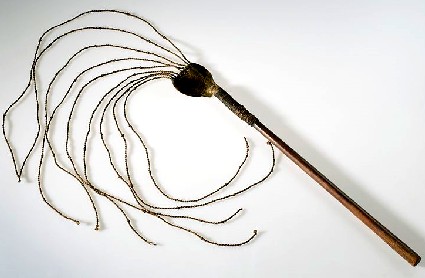
An 18th or early 19th century Cat of Nine Tails, Wellcome Collection
for purposes of clarity in the review of wounds in the period historical pirate literature, wounds that were a combination of broken and unbroken skin are discussed here. These could be caused by a variety of things including severe beating and, more particularly whipping.
While many beatings would have been likely resulted in bruises or unbroken skin wounds there was potential for tearing through the skin. Broken skin would be most likely to result from intense beatings. Several modifiers to the standard description of a beating were used in the period pirate literature. These beatings were variously referred to being 'unmerciful'1, 'handsome'2, 'barbarous'3, "severe"4, 'heartily'5 and cruel6. While such adjectives do not directly state that a wound would have broken the skin, the likelihood is greater.
The wound that would be most likely to produce both serious bruising and broken skins was whipping or flogging (flogging could also be performed with a rod, although this seems to have mostly been employed in the period before the golden age of piracy7). Whipping was a fairly popular form of punishment during the golden age of piracy on ships - naval, merchant and pirate. Because there is so much support for it, we will focus on whipping being used on pirate ships here.
Whipping was so popular, it was codified into several pirate articles as punishment. (Pirate articles served as the basic rules of behavior aboard many of the pirate ships. It is not found in all of the existing sets of article, however; each set of articles was unique to the crew that made them.)
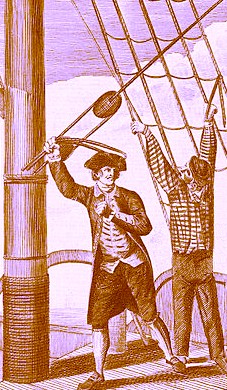
Artist: William Jackson
Flogging a Man, From Wellcome (1795)
Pirate John (Richard) Taylor's articles prescribed flogging for failing to hand over a prize's plunder to the quartermaster.8 Those men found gambling on Thomas Anstis' ship to "the value of one Real plate [probably referring to one silver reale or 1/8 of a silver piece of eight] shall suffer Moses' Law"9. ('Moses' Law' was to receive 39 lashes to the back.) John Phillips' articles meted out the same punishment for any "Man that shall strike another whilst these Articles are in force"as well as men found igniting or carrying unguarded sparks and flames in the hold of the ship.10
Curiously, punishment by the whip was actually tame when compared to other articles which resulted in slitting a man's ears and nose11, marooning or death.12 It should be noted that the rules about punishment seem to have been somewhat fluid. Although Bartholomew Robert's articles do not include a provision for attempted escape, William Williams "receiv'd two Lashes from every Man in the Company as a Punishment" for attempting to escape from the pirates.13
Whipping was used as a general punishment on pirates ships for various offenses. Like William Williams, pirate Peter Hoff "was once whip'd for attempting to Run away" from Samuel Bellamy's crew.14 Two of Stede Bonnet's crew were whipped for some unspecified transgression.15 Bartholomew Robert's men were convinced to join his crew "by such uncivil Methods, as whipping, or beating"16
Whipping was also used on men captured by the pirates for various purposes. Bonnet threatened to whip James Killing, Mate of the Francis, "if I did not confess all I knew."17 Pirate Benjamin Jeffreys of Bartholomew Roberts' crew was given six lashes by every pirate "for telling these Pyrates, that none who could get their Bread in an honest way would be on such an Account."18 A witness said Jeffreys did this "because in his Liquor he had been so saucy"19.
With all this support for simple broken and unbroken skin wounds, the pirate surgeon would clearly have had many opportunities to care for such wounds. Let's look at how such wounds were treated.
1 See for example Captain Charles Johnson, The General History of the Pyrates, p. 130 (Captain Edward England), p. 316 (Roberts); 2 Johnson, General History, p. 249 (Roberts); A Full Account of the Tryal Of all the Pyrates Lately taken by Captain OGLE, 1723, p. 28; 3 Johnson, General History, p. 416 (Spriggs); 4 Captain Charles Johnson, The History of the Pirates, p. 162 (Cornelius), 5 Johnson, History of the Pirates, p. 163 (Cornelius), 6 Johnson, General History, p. 359 (Lowther); 7 Ed Fox, Piratical Schemes and Contracts, Diss. University of Exeter, May 2013, p. 241; 8 Fox, p. 315; 9 Fox, p. 320; 10 Johnson, General History, p. 398; 10 Part of Bartholomew Robert's crew's punishment for stealing from another man - Johnson, General History, p. 231 and Deserters from John Taylor's crew - Fox, p. 315; 12 Found in many sets of articles including John (Richard) Taylor (Fox, p. 315), Bartholomew Roberts (Johnson, General History, p. 280 & 282) and Thomas Anstis (Fox, p. 319 & 320) among others; 13 Pyrates Lately taken by Captain OGLE, p. 19; 14 The Trials of Eight Persons Indited for Piracy, 1718, p. 24; 15 Johnson, General History, p. 318; 16 Johnson, General History, p. 318; 17 The Tryals of Major Stede Bonnet, 1719, p. 14; 18,19 Pyrates Lately taken by Captain OGLE, p. 74
Theories of Naturally-Based Simple Wound Care
One of the theories of wound care was to let wounds heal naturally, at least in part. This was often mentioned by surgeon's books that predated the golden age of piracy, but which were still around during the beginning of the period.
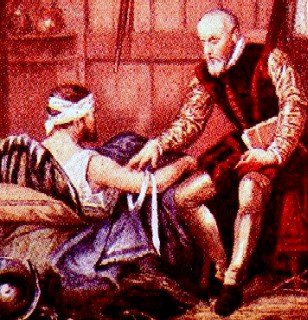
Artist: E. Hamman
Ambroise Paré Bandaging a Patient's Wound
Sea surgeon John Woodall advised that simple wounds "that are only in the skin or flesh have no difficile [difficult] cure: for oft-times Nature with some easie remedy, or a Ligature [tight bandage] only doth helpe them"1.
French surgeon Ambroise Paré gave more specific advice about how the surgeon should go about allowing wounds to heal naturally. With regard to removing foreign bodies from broken skin wounds, he warned his reader not to be "too hasty taking forth of such like bodies [when] there bee feare of cruell paine or great effusion of blood, it will be farre better to commit the whole worke to nature than to exasperate the Wound by too violent hastening."2 He went on to explain that "nature by little and little will exclude, as contrary to it, or else together with the Pus, what strange body soever shall be contayned in the wounded part."3 He further said that if action must be taken by the surgeon to treat wounds, "it will bee fit the Chirurgion fall to worke quickely, safely, and as mildely as the thing will suffer, for effusion of blood, swooning, convulsion and other horrid symptomes, follow upon the too rough and boystrous handling of Wounds"4.
However surgical authors from the period (including Woodall and Paré ) primarily recommended more active treatments.
1 John Woodall, the surgions mate, 1617, p. 130; 2,3,4 Ambroise Paré, The Workes of that Famous Chirurgion Ambrose Parey, 1649, p. 254
Theories of Surgically-Based Simple Wound Care in Broken Skin Wounds
In broad terms, we look at wound in two categories - broken skin wounds and unbroken skin wound. Of the two types, the cure of broken skin wounds was obviously the more complicated. Both Paré and English military surgeon Richard Wiseman present five steps for dealing with broken skin wounds with Wiseman noting that "the omitting of any [step] of which will render him [the surgeon] negligent or ignorant in his Trade"1. These five steps originated in the third volume of French surgeon Guy De Chauliac's 1363 seven part book La Grande Chirurgie.2 Like many of the revered 'ancients', the steps continued to live as a recommended method of care for wounds by being passed down through various surgical authors well into the golden age of piracy. The steps include:
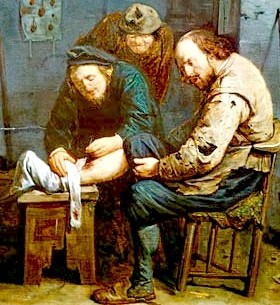
Artist: David Ryckaert
-Dressing a Leg Fracture, The Surgeon (1638)
Step 1: Remove all foreign objects from the wound, which "may hinder the true Agglutination of the disjoynted Parts, whether they be concrete Bloud, Hair, Sand, Dust, pieces of Bones, Cartilages, or pieces of the Weapons, Rags &c."3Paré advises this must be done "whether they have come from without, or from within the body, and shall be by accident fastened or stucke in the wound, he [the surgeon] must take them away, for otherwise there is no union to be expected."4
Step 2: Bring "the Lips of the Wound even together, which were separated"5, "for they cannot otherwise be agglutinated ['re-glued] and united."6
Step 3: Once the lips of the wound are together, "keepe close together the joyned lippes"7, "that they may by Consolidation be restored to their former figure."8
Step 4: "[P]reserve the temper of the wounded part, for the distemper remaining, it is impossible to restore it to its unity."9
Step 5: To prevent complications or "ill Accidents, and correcting such as have already seized on the Part"10 "because these urging, the Physition is often forced to change the order of the cure."11
While he didn't arrange wound care by delineated steps, sea surgeon John Woodall did mention the five steps used by Wiseman and Paré when

Author John Woodall
describing simple wound treatment in narrative fashion:
...if by medicine their [simple wounds] cure consisteth both in the reduction [re-uniting] of parts disjoined and dislocated, to union, [step 2] and in consolidation and true conglutination of them: therefore it shall be necessary to consider that if any thing hinder consolidation it be removed [step 1]: that reduction be rightly and skilfully wrought, lest the parts adjoyned fall into relaps [step 3], and that the substance of the part with his naturall temperament be conserved [step 4]: and lastly, that the symptoms be prevented and carefully cured as they arise [step 5].12
German military surgeon Matthias Gottfried Purmann also lists the first four steps in this process in the same order as Wiseman and Paré in a narrative form13, so there is a great deal of support for the use of this method of healing wounds during this period.
Note that the wording of some of these steps is a bit unclear, especially given the modern method for wound care. For example, stopping bleeding from a broken skin wound is not mentioned, but Wiseman elsewhere explains that bleeding would by stopped when step 3 - the bringing of the lips of the wound together - was performed14. Step 4, preserving the temper or (as Wiseman puts it) temperament15 of the wound sounds a bit abstruse to the modern reader. It refers to various post-operative procedures including having the patient rest, maintaining a healthy diet and making sure the wound is treated with appropriate medicines. All of these things will be discussed in detail later in this article.
1 Richard Wiseman, Severall Chirurgicall Treatises, 1676, p. 340; 2 Basil A. Pruitt, Jr., "Combat Casualty Care and Surgical Progress", Annals of Surgery, June, 2006, June, p. 716; 3 Wiseman,p. 340; 4 Ambroise Paré, The Workes of that Famous Chirurgion Ambrose Parey, 1649, p. 253; 5 Wiseman, p. 340; 6,7 Paré, p. 254; 8 Wiseman, p. 340; 9 Paré, p. 254; 10 Wiseman, p. 340; 11 Paré, p. 254; 12John Woodall, the surgions mate, 1617, p. 128; 13 Matthias Gottfried Purmann, Churgia Curiosa, 1706, p. 181; 14 See Wiseman, p. 351; 13 Wiseman, p. 340

